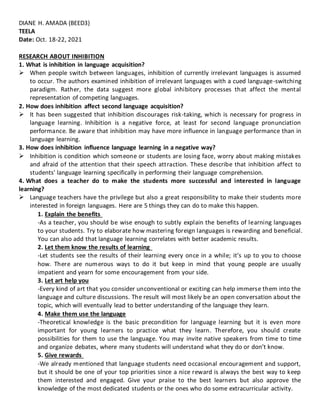
Teela,oct 18 22
- 1. DIANE H. AMADA (BEED3) TEELA Date: Oct. 18-22, 2021 RESEARCH ABOUT INHIBITION 1. What is inhibition in language acquisition? When people switch between languages, inhibition of currently irrelevant languages is assumed to occur. The authors examined inhibition of irrelevant languages with a cued language-switching paradigm. Rather, the data suggest more global inhibitory processes that affect the mental representation of competing languages. 2. How does inhibition affect second language acquisition? It has been suggested that inhibition discourages risk-taking, which is necessary for progress in language learning. Inhibition is a negative force, at least for second language pronunciation performance. Be aware that inhibition may have more influence in language performance than in language learning. 3. How does inhibition influence language learning in a negative way? Inhibition is condition which someone or students are losing face, worry about making mistakes and afraid of the attention that their speech attraction. These describe that inhibition affect to students' language learning specifically in performing their language comprehension. 4. What does a teacher do to make the students more successful and interested in language learning? Language teachers have the privilege but also a great responsibility to make their students more interested in foreign languages. Here are 5 things they can do to make this happen. 1. Explain the benefits -As a teacher, you should be wise enough to subtly explain the benefits of learning languages to your students. Try to elaborate how mastering foreign languages is rewarding and beneficial. You can also add that language learning correlates with better academic results. 2. Let them know the results of learning -Let students see the results of their learning every once in a while; it’s up to you to choose how. There are numerous ways to do it but keep in mind that young people are usually impatient and yearn for some encouragement from your side. 3. Let art help you -Every kind of art that you consider unconventional or exciting can help immerse them into the language and culture discussions. The result will most likely be an open conversation about the topic, which will eventually lead to better understanding of the language they learn. 4. Make them use the language -Theoretical knowledge is the basic precondition for language learning but it is even more important for young learners to practice what they learn. Therefore, you should create possibilities for them to use the language. You may invite native speakers from time to time and organize debates, where many students will understand what they do or don’t know. 5. Give rewards -We already mentioned that language students need occasional encouragement and support, but it should be one of your top priorities since a nice reward is always the best way to keep them interested and engaged. Give your praise to the best learners but also approve the knowledge of the most dedicated students or the ones who do some extracurricular activity.
- 2. 5.Differentiate a left brain dominated student with a right brain dominated student There are differences of opinion when it comes to brain hemisphere dominance, one thing seems clear: there are some students who are more comfortable with logic and reasoning than they are with creativity and intuition. These preferences are characteristic of people who are sometimes called left brain dominant. And If you're mostly analytical and methodical in your thinking, you're said to be left-brained. If you tend to be more creative or artistic, you're thought to be right- brained. In general the right dominated students enjoy the social aspects in class and might get bored easily. 6. Cite example for each situation Left brain dominated student Goal-setters -targeting the lowest class average in order to raise overall GPA. Right brain dominated student Creative -enjoys learning new things, so their free time may include reading books or watching videos about topics they find interesting. 7.Differentiate the characteristics of each of the 4 modalities of learning modalities (these modalities are the learning styles of students). The four widely accepted learning modalities (or modes) are known by the acronym VARK: Visual, Auditory, Aural, Reading/Writing, and Kinesthetic. They are sometimes inaccurately referred to as “learning styles” which implies that each learner has a “style” of learning that should be maximized in all learning situations. Visual Auditory - Visual Learners: those that need to see pictures and graphs to visualize. Auditory Learners: those who need to hear the information. For example, a visual learner will want to see an example of the project, while someone who has an auditory focus will prefer to hear about the project. Students who prefer auditory learning over tactile or visual will be focused on listening instead of seeing, reading, or physically trying in order to learn. Aural - The aural learning style is a style in which individuals learn best through hearing directions and speaking answers. It is common for aural learners to be proficient at speaking and acting. Typically, aural learners prefer to listen to lectures rather than take notes. Reading and Writing - Sometimes known as the second visual modality for learning, reading and writing is a learning style where individuals are able to absorb and retain the most information through reading and writing text, versus imagery and symbolism. Kinesthetic - A kinesthetic-tactile learning style requires that you manipulate or touch material to learn. Kinesthetic-tactile techniques are used in combination with visual and/or auditory study techniques, producing multi-sensory learning. Kinaesthetic learning happens when we have a hands- on experience. An example of a kinaesthetic learning experience is when a child learns to use a swing or to ride a bike. They can read instructions or listen to instructions, but deep learning occurs via the process of doing.